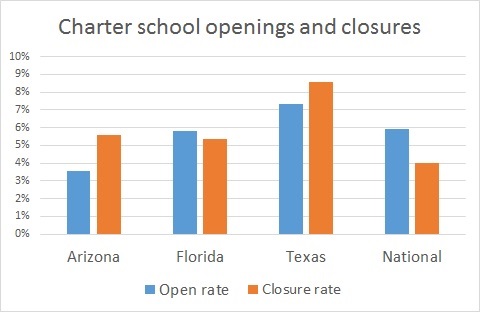Florida saw more charter schools shut down than any other state last year, according to a new report from an advocacy group.
The report from the National Alliance for Public Charter Schools breaks down trends in the charter school movement. It shows that, in a departure from the recent past, the total number of charters in Florida held almost steady in over the past year.
The 38 new charters that opened this fall were offset by 35 that closed during the 2014-15 school year, according to the report. State Department of Education records list another three schools that closed before the current school year began.
Florida might be expected to have a large number of closures since it has 656 charters, the third-most in the country, but the report shows the Sunshine State’s closure rate is disproportionately high. Florida is home to slightly less than 10 percent of the charters operating in the country, but accounted for nearly 14 percent of closures last school year.

Florida’s closure rate, of nearly 5.4 percent, topped the nation average of 4 percent, but was eclipsed by states like Arizona and Texas. Like Florida, they are known to be less heavy on charter school regulation than states like Colorado or Massachusetts. This has led some charter supporters to posit that charter authorizers in the so-called FAT states are cracking down on schools that aren’t performing.
There may be some truth to that. But a many of Florida’s closures can be chalked up to schools like the Acclaim Academy network, which imploded in the middle of the school year and shuttered schools in Jacksonville and Orlando after its Osceola County school was closed for academic failure.
There is also some noise in the school closure numbers, since they can include mergers. Tallahassee’s Stars Middle School, for example, is listed by the Department of Education among last year’s 35 “closed” charters, but it shut down only on paper. It actually expanded into the elementary grades and reconstituted itself as a K-8.
The charter alliance’s report notes that schools close for a variety of reasons, but says the stats show the charter model is working. Rather than languishing with shoddy finances and poor academics, schools are closing and potentially creating room for better ones to take their place.
The charter public school model gives charter schools the freedom to be more innovative, while being held accountable for improving student achievement. The school closures provide evidence that the accountability part of the charter school model is being upheld.
But many charter school advocates would likely say there are still too many bad closures, where schools shut down all of a sudden in the middle of the school year, and not enough good ones, where districts proactively shut down poorly run schools in an orderly fashion.
Perhaps better yet, they would stop the worst schools from opening in the first place, while also treating the better charter school organizations fairly and encouraging them to start new, better schools in place of the ones that close.


